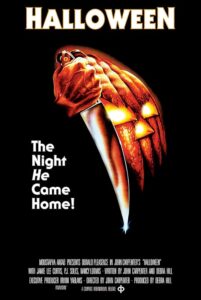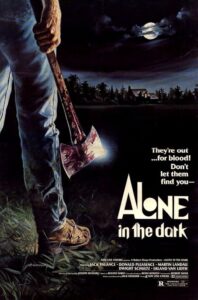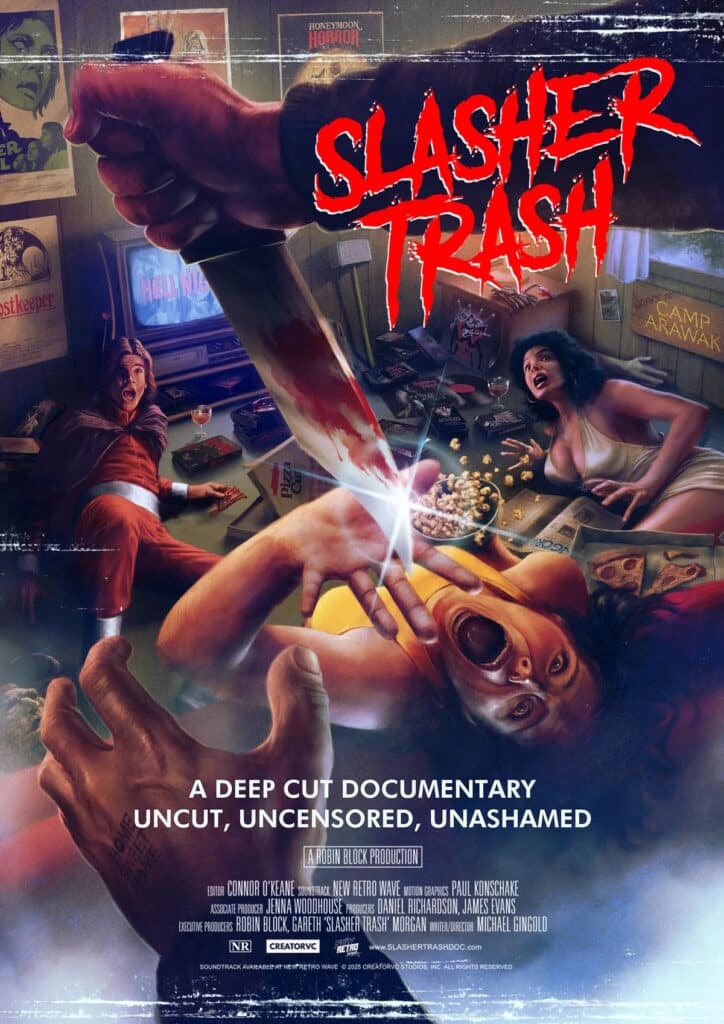By WILLIAM J. WRIGHT
Codified as “The Rules” in the 1996 blockbuster Scream and virtually encoded in the DNA of every horror fan, we all know the requisite tropes that define slasher films: A killer (usually masked) stalks a cadre of disposable teens (mostly young women), eliminating them one by one in novel, often Rube Goldbergian ways until one (the “final girl,” as defined by Carol J. Clover in her essential Men, Women, and Chainsaws) remains to face down the terror alone… And then, a twist ending to set up the inevitable sequel. Buoyed by such long-running franchises as Friday the 13th, A Nightmare on Elm Street and Child’s Play (all of which were built on the success of John Carpenter’s genre-defining 1978 classic Halloween), slasher films reached their peak, arguably their nadir, in the 1980s. With the mainstream success and enduring popularity of Freddy, Jason, Chucky, and Michael, it’s easy to think of these franchises as the whole of the subgenre. Despite the ink spilled and video committed to tape and hard drive about these beloved films, they were only the cresting waves on a bloody ocean of slashers that ranged from big studio releases to gory, Z-grade spectacles – movies still revered and celebrated by hardcore gorehounds and exploitation fanatics.
SLASHER TRASH, the upcoming documentary from CREATORVC, the production team behind the expansive In Search of Darkness series, delves into those little-known, underappreciated, obscure and forgotten slasher gems. At the helm of this ambitious project is Michael Gingold, one of the foremost voices in genre scholarship and journalism and RUE MORGUE’s head writer. With a career spanning decades, Gingold is a uniquely qualified director whose enthusiasm for horror remains unmatched. Recently, Gingold, whom I’m proud to call my colleague, sat down with me to discuss this ambitious labor of love.
When most casual movie fans and probably even most horror fans think of slashers, they think of the big 1980s franchises. SLASHER TRASH does not deal with those films. What is this doc all about, and what kinds of films are you covering?

Michael Gingold, director of “SLASHER TRASH”
Well, that’s exactly the idea. We’re not doing the household names, the Freddys and Jasons and Michaels that even people who are not horror enthusiasts know well. We’re going after the second-level ones, some of which were studio releases like My Bloody Valentine and Terror Train. But we’re also going for the very low-budget ones, the independent ones, the crazier ones that came out of the trend – even some of the ones that were shot on video. We want to run the whole spectrum of all the slasher films that only hardcore fans might know, and maybe even a couple that hardcore fans aren’t aware of.
How did you get involved with CREATORVC and this project?
Robin Block from CREATORVC spoke to me about doing this. I was interviewed for In Search of Darkness. That’s kind of how this all got started. I was interviewed for that several years ago, and then they came to me when they had this project and asked me to work with them on it. So, I’ve been working with Robin and [CREATORVC producer] Daniel Richardson and Gareth “Slasher Trash” Morgan and the rest of the team. We’re all working together to really make this the ultimate slasher documentary, to make it the last word in exploring this subgenre.
Tell me about the community that inspired this project.
Well, it kind of has its origins in the “Slasher Trash” Facebook group that Gareth Morgan runs. It’s all kind of based on that. That’s where it gets its name from. Gareth is producing this, and he probably knows even more about slasher movies than I do, and so far, he’s already been a great resource, and I look forward to working with him very closely as we get through development and into shooting.
You’ve done several documentary projects and featurettes. How in-depth is this film compared to other things that you’ve done? Do you anticipate any particular challenges? This is a very big topic.
We’re aiming for about a four-hour product, so we have a lot of time to cover the many different facets of the slasher genre. We’re going to cover all the crazy killers we’ve had, all the crazy kills, the whole history of the genre. Well, not the whole history. I shouldn’t say that. We’re aiming for kind of the post-Halloween slasher trend, though. We are going to talk about some of the earlier favorites, like Black Christmas, for example. And we just really want to get into the whole spectrum of why these movies are so much fun, why they continue to appeal to people to this day.
We’re in crowdfunding right now. We’re going to go into production a little later this year. And I think maybe the challenge would be to find the right mix of people who can speak to all of the different films that were out there. You know, if we were doing this about Freddy, Jason and Michael, it would be easy to find a lot of people and talk about them, but we’re trying to find people who can speak to the more obscure stuff, even down to the shot on video stuff – filmmakers who can talk about making them and what that process and what the climate was like back then, when horror was not looked upon as favorably as it is today, and slasher films, especially, attracted a lot of controversy.
[We also want to speak with] fans and experts who know their stuff and know the kind of lesser-known slasher films. We definitely want this to appeal to the hardcore fans, but we also want this to introduce people to a lot of films they might not be aware of. You know, it would be something like Not Quite Hollywood. I saw that film and came away with a list of about 25 movies I needed to see. And the same is true here. We’re hoping that some people will see this who are slasher fans but may not know about some of the more obscure titles and will come away saying, “Hey, I need to see that one.”
Do you have a dream interview for this project? Anyone specifically that you’d like to track down?
Oh, man, that’s a good question. Maybe I shouldn’t say anything because we’re in the process of tracking down a couple of people that we really want. I don’t want to jinx it. We’ll be making announcements soon.
In your mind, what are the essential elements of a perfect slasher film?
You have to have a memorable killer and some memorable kills as well. Slashers got pretty creative with the kills. Back in the ’80s, the films were kind of trying to outdo each other, sometimes, like being outrageous with them. You even had a movie like Happy Birthday to Me, where the entire ad campaign centers on how weird and creative the kills are, and it has to be scary. That’s the ultimate goal. Some of these films are scary, some are just kind of fun and outrageous to watch, but they all need that little something that will set them apart from all the other slasher films that were out there.
How did you become aware of slashers as a young horror fan, and what effect did that have on you?

You were seen as weird if you really liked this kind of film because there was a lot of publicity about how misogynistic they were, how violent they were, and how disgusting, and they were considered the unwholesome side of the film industry. Horror films, in a certain sense, were seen as just a step above pornography. So, it wasn’t as cool to be a horror fan back then as it is now, and the films weren’t taken as seriously as they are now. A lot of them were just dismissed. So, I hung in there, and I went to see almost everything that came out, and I have carried that fandom with me to this day.
Many of these films came out of the exploitation/grindhouse tradition. What is it about these movies that people like you and me and other horror fans like? What attracts us to slashers?
Well, I think slasher films are kind of, how do I put this? They’re not realistic, but they take off from a realistic premise. Most people are not really afraid of a ghost or a vampire or something coming after them. But slasher films kind of tap into the fear of another person coming after you, which is a real thing that does happen. A few of these films were based on real cases. I think that’s part of the appeal. You can put yourself into the situation more than in other horror films, even though some of the slasher films got outrageous and unbelievable with their scenarios and the killers.
And then there are those sometimes well-founded accusations of misogyny and social irresponsibility. What are your thoughts about that? Outside of the horror genre, where do slashers fit in with the larger culture?
I think some of those films kind of bordered on being misogynistic. I don’t want to single out any particular titles – certain ones were more than others. And I think because what happens in them is a little more identifiable, that kind of triggered people to see them as misogynistic. These are essentially crimes that happen in real life, and some people saw them as exploitative. They objected to the gore. It’s kind of interesting that some of the slasher films that come out now are much gorier with our ratings than they were allowed to be in the ’80s, but the violence doesn’t seem to impact people as much. You have a remake of Silent Night, Deadly Night coming out soon, which is highly unlikely to attract all the controversy that the first one did when it opened in theaters. I think people are a little more open-minded about them. Back then, they were definitely a point of controversy. And you had Siskel and Ebert doing a whole show, basically putting them down, and they attracted a lot of negative press.
Is there a cyclical nature to the popularity of slasher films? We had a peak in the 1980s, and then a revival in the ’90s.
You definitely had all the post-Halloween films, and those kind of petered out as the market just became saturated. Then, you had the revival with Scream back in the late ’90s. And now, I think slashers are just kind of part of the landscape. We’re not in the middle of any one particular cycle right now. We’re seeing all different kinds of horror films being made. They’re part of the genre as a whole and not kind of a genre unto themselves as they were back in the ’80s. And that’s what we want to explore in the doc: What made this subgenre stand out among the horror films of the 1980s? Why were there so many of them? And what are some of the most fun examples of them, the ones that appeal to audiences the most?
Much of the current crop of slasher films seems bent on imitating that ’80s style.
Well, what’s happening is we’re having filmmakers now who grew up watching these movies in theaters or on video, who became fans of them when they were young, and now they’re making homages to them. I recently wrote a review where I said there seem to be as many homages to ’80s slasher films as there were ’80s slasher films. So, you have people who were young when these movies came out and became fans and really enjoyed how crazy they were, how scary they were, and now, they want to try to recapture that. And some of them are doing it in the ’80s style. They’re really kind of duplicating the ’80s filmmaking style.
Where does Terrifier fit in?

Do you find that slasher movie fans are a different breed than perhaps more typical horror fans? It seems that when I run into horror fans, I meet people who are fans of the genre as a whole, who love everything, and then some are exclusively into slashers. These films are the horror genre to them.
That’s a good question. Slasher fans will acknowledge that some of these films are better than others, but they just love the subgenre as a whole. They love the good, the bad and the ugly. They just embrace all examples of the form. So, I think that’s one of the things that sets them apart. They just love all of it, even as bad or silly as some of these movies can be. Sometimes, you can embrace the campiness of it in a movie like Pieces, which is ridiculous and over the top but very entertaining.
What are your recommendations for some lesser-known slasher films?

When will we be able to see SLASHER TRASH?
We’re hoping it’ll be out by next year, and if you go to the crowdfunding page, we’re going to be offering it on Blu-ray with a whole bunch of merch. Not sure where it’s going to go from there, but we’re definitely going to get it out in every way we can.
What else do you have coming up? Aside from all the incredible writing that you do for RUE MORGUE?
I have a book called Armies of the Night that I wrote with my friend Chris Poggiali. It’s all about The Warriors, and that’s coming out this fall from 1984 Publishing, the people who put out my Ad Nauseum books. There’s a bunch of Blu-ray extras that I’m working on. I can’t really talk about them. They like to keep these things under their hats until they’re announced. But I’m busy with all that. The big one is Armies of the Night. That’s a book that we’ve been working on on and off for about seven years, so we’re thrilled that that’s finally getting out there.
For more information and updates, see the official SLASHER TRASH website.




